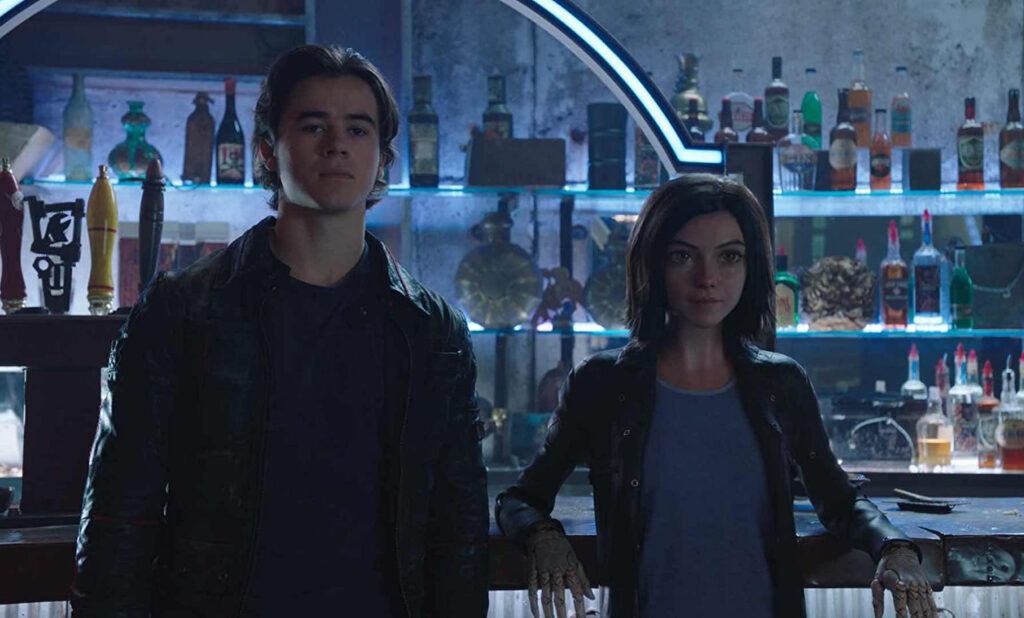“Alita: Battle Angel” tells us a story of a cyborg that is brought back to life after her decapitated head is attached to a brand-new body. The man responsible for saving her is doctor Ido, who names her Alita, after his deceased daughter. Soon after, we learn that the story is set in a futuristic ambiance, even apocalyptic world where humans coexist with cyborgs in a poor, dusty, and polluted Iron City.
As a more detailed introduction to the time-space of the film, we are presented with a historical explanation of a devastating war that led to the current situation the city lives in. The rest of the narrative is constructed around the principal character, Alita, who slowly but surely regains her memory: she was a warrior that lived in Zalem, a wealthy city ruled by an authoritarian leader Nova, that uses Iron City as a landfill, a pile of garbage where Alita’s dismembered body parts had been tossed out. She also meets Hugo, a human whose job is to collect cyborg body parts for Vector, the organizer of Motorball, a cyborg gladiator-like competition. Hugo hunts down cyborgs for the sole promise of traveling to Zalem and having a better life, but after falling in love with Alita, he finds himself unable to continue doing it.
Some other minor story knots build upon this main narrative strand and leave an open ending: after Hugo’s refusal to keep working for Vector, he’s murdered but saved by having his head attached to a cyborg body. He tries to reach Zalem but is now murdered for good by Nova, who doesn’t let anyone approach his city. Alita ends up being a Motorball champion and wins the final prize: a travel to Zalem.
Behind this seemingly chaotic plot, what hides is a quite simple and stereotypical one, one which offers more space for an exploration of the aesthetical dimension of colors, sounds, and collage, amongst other constituents of the film’s narrative, rather than to the character or plot development. However, Alita’s identity seems so much more complex when analyzed from a standpoint of the Cartesian body-mind dualism. After managing to remember her identity, Alita’s still quite aware of her body as a source of dissatisfaction, longing for a more technologically advanced one, more suited to her and her past self.
Even before these events, we witness doctor Ido reconstructing her identity while sewing the body of his daughter Alita to her head. Just as we read in Ljubica Arsic’s novel “Icon,” to a doctor a body doesn’t have a sex—it’s sexless, angelical. Therefore, Alita being a battle angel can be considered an intrinsic aspect of her personality: for what makes her a female cyborg is more than her body. Her female identity is more sharply delineated when taking into account the Zalem-Iron City dyad, Iron City being the Otherness.

After falling from Zalem, an emanation of the garden of Eden, Alita wakes up in Iron City, a sort of a sub-city, and undergoes a transforming process of decoding and becoming herself. She was granted an opportunity to come in terms with her own identity by falling through the tunnel that connects the two opposite cities and thus transgressing their borders, a clear example of the femaleness understood in philosophical terms, a notion that encompasses fluidity, dynamics, ambiguity, and perspectivism. This trespassing of Alita’s is a post-modern motif of nomadism, of seeing another world, another face of the reality.
Alita’s body is, to quote Rust Cohle, a paraphilic love map, a crossroad, that only in relation to others becomes a site of identity. That’s why Alita’s relationship to Hugo can be important: not only as a part of the narrative, which is the weakest point of the film, but as a means for understanding his sudden change of behavior. He’s unable to keep dismembering cyborgs’ bodies, not as a result of his newly found empathy and inner ethics, but rather as a self-realization and the annihilation of the body-mind dualism. The de-construction of the unity of mind and body becomes a re-construction, a forming of unity, and this reversible process is forever ongoing.
As in Julien Offray de La Mettrie’s “L’homme Machine,” the concept that denies the existence of a soul without matter can be interpreted in several different manners parting from “Alita: Battle Angel.” The correlation of the mind and the body equals the correlation of the being and becoming, of essence and matter. The essentialist notion of the mind as static and determined is challenged by Alita’s journey between the two worlds and her personal evolution, whilst the materialistic principle is also a subject of re-evaluation. Their codependence, however, points out that the time is surpassed by reaching immortality, as a more potent mind requires a more potent body, and vice versa. The cyborg is neither a product of essentialism nor of materialism, but more like of existentialism, which I dare to call a humanized materialism.
Another question emerges: could Nova be seen as a metaphor for a god? If we examine what little we know about him, we see that: he rules the edenic Zalem, he’s powerful, ruthless, and malevolent. Alita’s a battle angel, an over woman that’s revived by a scientist. Why would humanity need a god if science has achieved its full potential and is able to win the battle against death? Cyborgs of the world, unite! An open ending suggests a continuation of the film with its objective: to dethrone Nova.